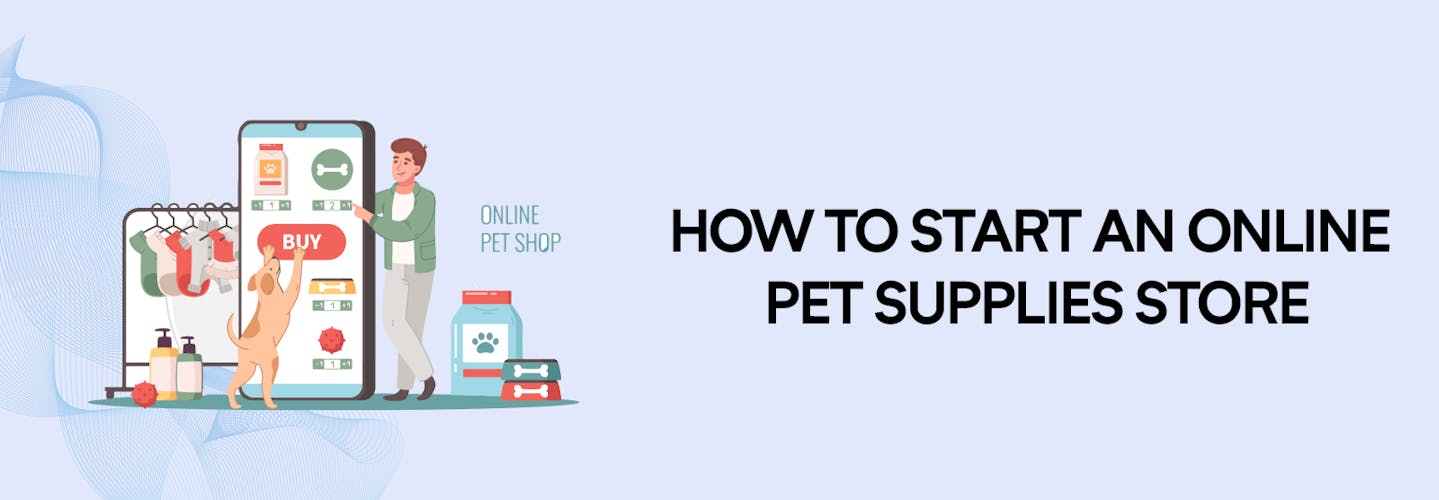
Starting Your Own Online Pet Supplies Business: A Comprehensive Guide
Pet owners are always looking for quality pet supplies to ensure their furry friends are healthy and happy.
Starting a pet supplies business online can be an excellent opportunity to tap into this growing industry.
According to a report by Grand View Research, the global pet food market size was valued at USD 99.1 billion in 2022 and is anticipated to exhibit a compound annual growth rate (CAGR) of 4.3% from 2023 to 2030.
Explanation of the Pet Supplies Industry
The pet supplies industry is vast and includes everything from food, treats, toys, grooming products, and healthcare items for pets.
With over 86.9 million households owning a pet in the United States alone as of 2023 according to American Pet Products Association (APPA), it’s not surprising that the pet industry has become a multi-billion dollar industry.
The market is highly competitive, with both big-box retailers and small independent stores selling pet products in-store and online. However, there is still plenty of room for new businesses to enter this exciting market.
Benefits of Starting a Pet Supplies Business Online

Starting an online pet supplies business offers several advantages over brick-and-mortar stores:
- Low overhead costs: an online store eliminates the need for physical store space, reducing overhead costs such as rent and utilities.
- Targeted marketing: with online marketing tools such as social media advertising and email marketing campaigns, you can target specific customers interested in your particular niche or products.
- Flexibility: operating an online business allows you to work from anywhere while still reaching customers worldwide.
- Better customer insights: with analytics tools available on most e-commerce platforms today, you can gain valuable insights into your customers’ preferences and shopping behavior through data analysis.
- 24/7 availability: an online store is open 24 hours a day, seven days a week, allowing customers to browse and shop whenever it’s convenient for them.
Brief Overview of the Steps to Start a Pet Supplies Business Online
To start your pet supplies business online, you need to follow several key steps:
- Market research: Identify your target audience and their needs. Analyze competitors in the market and determine your product offerings and pricing strategy.
- Business planning: Create a business plan that includes goals, objectives, financial projections, and obtaining necessary licenses and permits. Establish partnerships with suppliers.
- Website development: Choose an e-commerce platform that suits your needs. Design an attractive website that is user-friendly. Integrate payment gateways.
- Product sourcing and inventory management: Identify reliable suppliers for your products. Manage inventory levels to ensure adequate stock. Develop processes for order fulfillment and shipping.
- Marketing strategies: Develop a marketing plan that includes social media advertising, email marketing, content marketing, etc. Build brand awareness through influencer marketing campaigns. Optimize website content for SEO (Search Engine Optimization).
- Providing Excellent Customer Service: Ensure you provide top-notch customer service to retain customers and encourage repeat business. Respond to inquiries and address concerns efficiently. Offer a hassle-free return and exchange policy. Solicit and utilize customer feedback to improve your products and services.
- Monitor and optimize your store’s performance: Regularly track and analyze your store’s performance using analytics tools. Identify areas for improvement and implement changes to enhance your store’s online presence, customer experience, and overall profitability.
In the following sections of this article, we will dive deeper into each step required to start an online pet supplies business successfully.
1. Market Research and Analysis

A. Identifying target audience and customer needs
Before starting a pet supplies business online, it’s crucial to have a clear understanding of your target audience and their needs.
This includes identifying the type of pets your customers have, their demographics, geographic location, and lifestyle.
For example, if your target audience is busy urbanites with small dogs or cats, they may be more interested in pet products that are portable and easy to use on the go.
Conducting market research through surveys, focus groups or online analytics can help you gain insight into your target audience’s behavior and preferences.
By gathering this information and using it to tailor your product offerings accordingly, you can create products that better meet the needs of your customers.
B. Analyzing competitors in the market
Analyzing competitors in the market can provide valuable information on what works well and what doesn’t for similar businesses.
Look at other pet supplies businesses’ websites to get an idea of their product offerings, pricing strategy, marketing tactics, website design etc.
Identify gaps in the market that you could fill with unique products or services that aren’t currently being offered by other companies.
By differentiating yourself from competitors through offering something new or innovative you will be able to attract more customers who are looking for something different than what is currently available.
It’s important not only to look at local competition but also check online options from across regions as they may offer new ideas or more competitive prices that could be replicated locally.
C. Determining product offerings
Now that you know who your target audience is and have identified areas where there are gaps in the market it’s time to determine which products will best suit both customer needs and company goals.
Consider creating a range of pet supplies products including food/treats/medications as well as accessories like collars/leashes/toys.
When selecting your products, keep in mind your target audience and competitors to ensure that you are offering something unique and valuable.
You could differentiate your business by sourcing high-quality products that are difficult to find elsewhere or focus on a specific niche like eco-friendly pet products.
D. Pricing strategy
Determining the appropriate pricing for your pet supplies can be tricky as there are various factors to consider.
You want to make sure that you are making a profit while still being competitive with other businesses in the market.
To set prices, consider costs such as product costs, website development, shipping fees etc. Also, think about what price point will appeal best to your target audience.
Higher-end products may be more expensive but could attract customers who value quality over cost.
Remember to reassess pricing regularly - it’s important to stay competitive over time and adjust prices if necessary based on customer feedback or changes in the market.
2. Business Planning

A. Creating a Business Plan: Objectives, Goals, and Financial Projections
A business plan is the foundation of any successful business. The first step in creating a business plan is to establish your objectives and goals.
This includes identifying your target audience, determining your product offerings and pricing strategy, and outlining the marketing plan.
Your financial projections should include a detailed analysis of anticipated revenue streams, expenses, and profit margins.
Be sure to consider start-up costs such as website development, product sourcing, inventory management software or systems.
Another important aspect of creating a business plan is to conduct market research on your competitors within the pet supplies industry.
This will allow you to identify their strengths and weaknesses in order to differentiate yourself from others in the market.
B. Obtaining Necessary Licenses and Permits
Depending on the state or country you reside in, there may be specific licenses or permits required for starting an online pet supplies business.
To ensure that you are operating legally it’s important to research what permits are needed for your specific location.
It’s also essential that you obtain any necessary tax identification numbers for sales tax purposes if selling within the United States.
C. Establishing Partnerships with Suppliers
To run an online pet supplies store effectively it’s essential that you source high-quality products from reliable suppliers whom you can trust.
One way of finding suppliers is through attending trade shows where you can easily meet wholesalers face-to-face.
Another option is by contacting manufacturers directly requesting information about distribution options they offer.
For new businesses with limited budgets partnering with local distributors can be a great way to save money on shipping fees while still being able to provide customers with quality products.
When partnering with suppliers always take careful consideration of their reliability in terms of delivering consistent quality products before deciding whether or not they should become part of your supply chain.
3. Website Development

Starting a pet supplies business online requires the development of a professional website.
A website is an essential component of any online business, as it serves as the first point of contact between you and your customers.
It is important to ensure that your website is designed with user experience in mind.
Creating a user-friendly and visually appealing interface will attract more visitors and boost the chances of converting them into paying customers.
A. Choosing an e-commerce platform that suits your needs
When choosing an e-commerce platform, there are numerous options to consider, including Aasaan, Shopify, WooCommerce, Magento and many more.
Each platform has its own unique features and benefits that cater to different business needs.
It is advisable to choose a platform based on the budget available, product types offered, scalability requirements, level of customizability needed and ease of use.
Aasaan can be an excellent platform for beginners because it offers various features such as payment integration options with Stripe or PayPal that make it easy to start selling online quickly.
In addition, Aasaan has a built-in content management system (CMS) that helps you create pages such as About Us or Contact pages without requiring any coding knowledge. WooCommerce can be ideal for those who have WordPress experience as it can integrate seamlessly with WordPress websites.
This makes it a great option if you want complete control over your website’s design and functionality.
Magento may be best suited for larger businesses due to its robust customizability options but may require more technical expertise in creating a fully functional store.
B. Designing an attractive website that is user-friendly
Your website’s design plays a significant role in attracting potential customers by creating visually appealing experiences while also providing clear navigation paths throughout your site.
It should also include high-quality images showcasing your products’ best features along with concise descriptions making it easier for visitors to find what they are looking for quickly.
A professional website should also be responsive across all devices, including smartphones and tablets.
This means that the website should be easy to navigate and read regardless of the screen size.
By having a mobile-friendly site, you are more likely to attract visitors who browse online using their mobile devices more often than desktop computers.
C. Integrating payment gateways
Payment gateways are an essential part of setting up an e-commerce store. They enable customers to pay for their purchases securely online using various payment options like credit cards or PayPal.
When choosing a payment gateway, it is important to consider transaction fees, security protocols, and ease of integration with your chosen e-commerce platform.
Some popular payment gateways include PayPal, Stripe and Authorize.net.
All these options offer different transaction fee structures and security protocols while providing easy integration with various e-commerce platforms.
Building a user-friendly and visually appealing website is critical to the success of any pet supplies business online.
Choosing the right platform that suits your needs, designing an attractive interface along with integrating secure payment gateways are all crucial steps when starting out in this field.
These factors will play a significant role in driving traffic to your website while maintaining customer trust by offering a safe and convenient shopping experience online.
4. Product Sourcing and Inventory Management

A. Identifying reliable suppliers for your products
When it comes to sourcing products for your pet supplies business, you want to find reliable suppliers that can provide you with high-quality items at a reasonable price.
Start by researching different suppliers and comparing their prices, product offerings, and delivery times.
Make sure to read reviews from other customers before committing to a supplier. Consider attending trade shows or reaching out to manufacturers directly to see if you can make a deal.
Another option is to work with a wholesale distributor who can provide access to multiple vendors in one place. This allows for greater flexibility in product selection and pricing.
It’s important to establish strong relationships with your suppliers as well, so be sure to communicate clearly and consistently about your needs. This includes providing accurate forecasts of expected sales volumes so they can plan accordingly.
B. Managing inventory levels to ensure adequate stock
Managing inventory levels is critical for the success of any e-commerce business, including pet supplies businesses.
It’s important to have enough stock on hand so that you don’t run out of popular items during peak demand periods, but not so much that it ties up too much capital or storage space.
To effectively manage inventory levels, consider using an inventory management system that tracks sales volume and automatically alerts you when it’s time to reorder certain items.
You’ll also want to perform regular physical counts of your stock on hand in order accurately forecast future needs.
Be prepared for unexpected events like supply chain disruptions or changes in customer demand trends.
Having contingency plans in place can help mitigate the impact these events may have on your inventory management strategy.
C. Developing processes for order fulfillment and shipping
Once you’ve established relationships with reliable suppliers and developed sound inventory management practices, the next step is developing processes for order fulfillment and shipping that enable efficient delivery of your products.
One important factor to consider is shipping costs and delivery times. Customers expect quick and affordable shipping options, so be sure to research carriers in your area and negotiate rates where possible.
You’ll also want to establish clear protocols for picking and packing orders, including quality control checks to ensure accurate fulfillment. Consider investing in technology like barcodes or RFID tags that can streamline this process.
Communication is key when it comes to order fulfillment and shipping. Make sure to provide customers with timely updates on their order status and tracking information so they can plan accordingly.
5. Marketing Strategies

A. Developing a Marketing Plan
Once your pet supplies business website is live, it’s time to focus on gaining visibility and driving traffic to your site.
One of the most effective ways to do so is through developing a marketing plan that includes social media advertising, email marketing, content marketing, and other digital advertising channels.
When creating social media campaigns, it is important to know what type of content resonates with your followers.
You can start by using Facebook Insights or Twitter Analytics to understand what times of day people interact with your content the most and which posts had the highest engagement rates.
B. Building Brand Awareness through Influencer Marketing Campaigns
One of the quickest ways to build brand awareness is through influencer marketing campaigns.
Influencers have large followings on social media platforms and can help you reach new audiences by promoting your products.
When working with influencers, it is important to choose them based on how relevant their audience is to your brand and ensure that their values align with yours.
A successful influencer campaign can be a game changer for any pet supplies business.
C. Optimizing Website Content for Search
Search engine optimization (SEO) involves creating user-friendly website content that ranks well in search engine results pages (SERPs).
By optimizing your website for search engines like Google or Bing, you can increase visibility and attract more traffic to your site organically.
To optimize website content for search, start by researching relevant keywords in the pet supplies industry and incorporating them into product descriptions or blog articles. It’s also essential that you create high-quality backlinks from reputable sources.
6. Providing Excellent Customer Service

Providing exceptional customer service is crucial for the success and growth of your online pet store. Keep these tips in mind to ensure your customers have a positive experience shopping with you:
A. Offer multiple communication channels:
Provide customers with various ways to get in touch with your customer support team, such as email, phone, live chat, and social media.
This enables customers to reach out using their preferred method and can lead to faster resolutions.
B. Respond promptly and professionally:
Ensure that your customer support team responds promptly and professionally to inquiries and complaints.
Quick, helpful responses can often turn a negative situation into a positive one, demonstrating your commitment to excellent service.
C. Provide clear and concise information:
Make sure that your website and customer support team provide accurate, up-to-date information about your products and services, shipping and return policies, and any other frequently asked questions.
D. Train your customer support team:
Invest in training your customer support team to ensure they have the knowledge and skills to assist customers effectively.
Provide them with the resources and tools to answer questions and resolve issues efficiently.
E. Personalize your customer interactions:
Treat each customer individually and tailor your responses to their specific needs and concerns.
Personalized interactions can make customers feel valued and create a more positive shopping experience.
F. Implement customer feedback:
Actively seek customer feedback and use it to improve your products, services, and overall customer experience.
Acknowledge and address any customer issues or concerns, demonstrating your commitment to their satisfaction.
G. Offer flexible return and exchange policies:
Develop fair and exchange policies that accommodate your customers. Communicate these policies on your website and ensure your customer support team is well-versed in handling such requests.
A flexible and hassle-free return process can instill trust and confidence in your brand.
H. Go the extra mile:
Surprise and delight your customers by exceeding their expectations whenever possible.
This can include offering free samples, sending personalized thank you notes, or providing unexpected discounts.
These gestures can create a memorable experience and encourage customer loyalty.
I. Measure customer satisfaction:
Regularly track and analyze customer satisfaction metrics, such as Net Promoter Score (NPS) or Customer Satisfaction Score (CSAT), to gain insights into your customers’ experiences and identify areas for improvement.
J. Continuously improve:
Use the feedback and insights gathered from customers and your customer satisfaction metrics to refine and improve your customer service processes, policies, and strategies.
Strive for constant growth and development, ensuring your online pet store remains a leader in providing excellent customer service.
7. Monitor and optimize your store’s performance

Regularly reviewing your online pet supply store’s performance is crucial for success. This includes analyzing sales data, website traffic, and customer feedback.
By understanding how your store is performing, you can identify areas for improvement and make necessary adjustments. Here are some ways to monitor and optimize your store’s performance:
- **Utilize analytics tools:**Use software like Google Analytics or other e-commerce analytics tools to track website traffic, conversion rates, and user behavior. This data will help you understand where your customers are coming from, what they are looking for, and how well your products sell.
- Customer surveys: Conduct customer surveys to collect feedback on your product offerings , website design, customer service, and overall shopping experience. Use this feedback to identify areas for improvement and implement changes accordingly.
- **A/B testing:**Implement A/B testing on various elements of your website, such as product descriptions, images, and calls-to-action. Comparing the performance of these variations can help you determine which changes are most effective in improving conversion rates and user engagement.
- **Monitor sales data:**Review sales data regularly to identify trends, top-selling products, and potential inventory issues. This information can guide you in making more informed decisions about product selection, pricing strategies, and promotions.
- Track customer reviews and interactions: Keep a close eye on customer reviews and interactions on your website, social media, and other platforms. Respond to positive and negative feedback, address concerns, and use this information to improve your customer service and overall store experience.
- **Invest in search engine optimization (SEO):**Optimize your website and product listings to rank higher on search engine results pages. This includes using relevant keywords, writing high-quality content, and ensuring a fast, mobile-friendly website.
- **Adjust marketing campaigns:**Regularly evaluate the performance of your marketing campaigns, such as social media advertising or email newsletters. Adjust your strategies based on what works best for your target audience and budget.
- Monitor competitors: Keep an eye on your competitors’ pricing, product offerings, and marketing strategies to stay competitive. Look for ways to differentiate your online pet store and offer unique value propositions to your customers.
- **Continuously update and refresh your website:**Regularly update your website with new product releases, promotional offers, and engaging content such as blog posts or articles to keep customers engaged and interested.
- Encourage customer loyalty: Implement loyalty programs, special offers, or personalized promotions to reward returning customers and encourage them to continue shopping at your online pet store. This can help boost customer retention and increase long-term revenue.
By continuously monitoring and optimizing your online pet supply store’s performance, you can make data-driven decisions to help your business thrive in the competitive pet industry.
Remember to stay adaptable, learn from your customer feedback, and be open to experimenting with new strategies and ideas.
As you grow and evolve, your online pet store will become a trusted destination for pet owners seeking high-quality products and exceptional customer service.
Conclusion:
Starting an online pet supplies business requires careful planning and execution but can be a rewarding experience if done correctly.
By conducting market research beforehand, developing a solid business plan, choosing reliable suppliers for products at reasonable prices, and following effective marketing strategies, you can build a thriving online pet supplies business.
Remember, brand awareness is key in the success of any e-commerce business.
So, prioritize building a strong brand image that resonates with your target customers through influencer marketing campaigns and search engine optimization techniques. Good Luck!
FAQ’S:
1. Is owning a pet store profitable?
Yes, owning a pet store can be profitable. The pet industry is a multi-billion dollar industry and the demand for pet-related products and services continues to grow. However, profitability can vary depending on factors such as location, competition, and the types of products and services offered.
2. What are the most effective marketing strategies for a new online pet supply business?
Establish a strong online presence through search engine optimization (SEO) and social media marketing. Offer competitive pricing, quality products, and exceptional customer service to build a loyal customer base.
3. What kind of products can I sell?
You can sell a variety of pet-related products such as food, treats, toys, grooming supplies, accessories, and healthcare products. You may also consider offering unique or niche products to differentiate yourself from competitors.
4. Do online pet shops offer pet supplies as well?
Yes, most online pet shops offer a wide range of pet supplies, including food, toys, grooming products, and accessories. Some even offer personalized recommendations based on your pet’s breed and needs.
5. Can I return a pet if I’m not satisfied with my purchase?
Most online pet shops have a return policy in place for pets, but it’s important to read the policy carefully before making a purchase. Generally, returns are only accepted for health reasons or if the pet arrives in poor condition. It’s important to be prepared for the responsibility of owning a pet before making a purchase.








